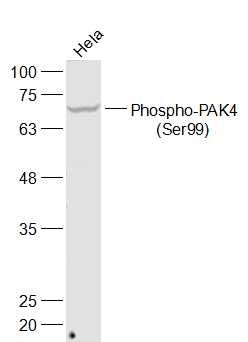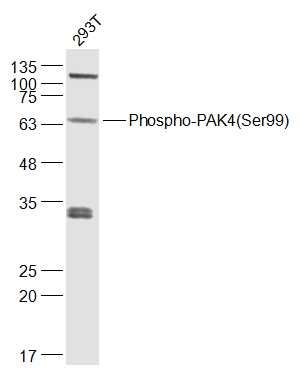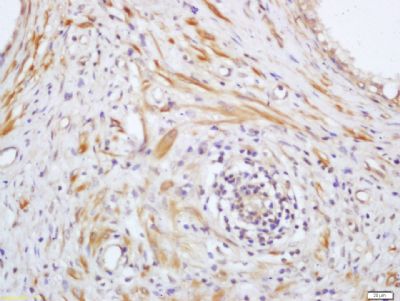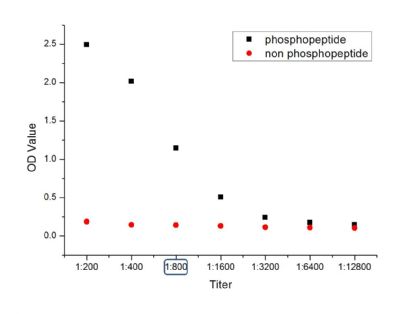产品中心
当前位置:首页>产品中心Anti-Phospho-PAK4(Ser99)
货号: bs-2270R 基本售价: 1580.0 元 规格: 100ul
产品信息
- 产品编号
- bs-2270R
- 英文名称
- Phospho-PAK4 (Ser99)
- 中文名称
- 磷酸化p21激活激酶4抗体
- 别 名
- p21 activated kinase 4 ; p21(CDKN1A) activated kinase 4; PAK 4; Protein kinase related to S.cerevisiae STE20 effector for Cdc42Hs; Serine threonine kinase PAK 4; Serine/threonine protein kinase PAK 4; Serine/threonine protein kinase PAK4; KIAA1142.
- 规格价格
- 100ul/1580元购买 大包装/询价
- 说 明 书
- 100ul
- 产品类型
- 磷酸化抗体
- 研究领域
- 肿瘤 细胞生物 免疫学 信号转导 细胞凋亡 转录调节因子 激酶和磷酸酶
- 抗体来源
- Rabbit
- 克隆类型
- Polyclonal
- 交叉反应
- Human, Mouse, Rat, Chicken, Dog, Cow, Horse, Rabbit,
- 产品应用
- WB=1:500-2000 ELISA=1:500-1000 IHC-P=1:400-800 IHC-F=1:400-800 IF=1:100-500 (石蜡切片需做抗原修复)
not yet tested in other applications.
optimal dilutions/concentrations should be determined by the end user.
- 分 子 量
- 64kDa
- 细胞定位
- 细胞浆
- 性 状
- Lyophilized or Liquid
- 浓 度
- 1mg/ml
- 免 疫 原
- KLH conjugated Synthesised phosphopeptide derived from human PAK4 around the phosphorylation site of Ser99:SN(p-S)LR
- 亚 型
- IgG
- 纯化方法
- affinity purified by Protein A
- 储 存 液
- 0.01M TBS(pH7.4) with 1% BSA, 0.03% Proclin300 and 50% Glycerol.
- 保存条件
- Store at -20 °C for one year. Avoid repeated freeze/thaw cycles. The lyophilized antibody is stable at room temperature for at least one month and for greater than a year when kept at -20°C. When reconstituted in sterile pH 7.4 0.01M PBS or diluent of antibody the antibody is stable for at least two weeks at 2-4 °C.
- PubMed
- PubMed
- 产品介绍
- background:
p21-activated kinases (PAKs) belong to the family of serine/threonine kinases involved in the control of various cellular processes, including the cell cycle, dynamics of the cytoskeleton, apoptosis, oncogenic transformation, and transcription. All PAK family members are characterized by the presence of p21-binding domain. p21-activated kinases are regulated by the small GTP-binding proteins Rac and Cdc42, and lipids, which stimulate autophosphorylation and phosphorylation of exogenous substrates. Serine (Ser-474) is the likely autophosphorylation site in the kinase domain of PAK4 in vivo. Phosphospecific antibodies directed against serine 474 detect activated PAK4 on the Golgi membrane when PAK4 is co-expressed with activated Cdc42. Current data strongly implicates PAK-4 in oncogenesis. PAK4 is frequently overexpressed in human tumor cell lines of various tissue origins.
Function:
Serine/threonine protein kinase that plays a role in a variety of different signaling pathways including cytoskeleton regulation, cell migration, growth, proliferation or cell survival. Activation by various effectors including growth factor receptors or active CDC42 and RAC1 results in a conformational change and a subsequent autophosphorylation on several serine and/or threonine residues. Phosphorylates and inactivates the protein phosphatase SSH1, leading to increased inhibitory phosphorylation of the actin binding/depolymerizing factor cofilin. Decreased cofilin activity may lead to stabilization of actin filaments. Phosphorylates LIMK1, a kinase that also inhibits the activity of cofilin. Phosphorylates integrin beta5/ITGB5 and thus regulates cell motility. Phosphorylates ARHGEF2 and activates the downstream target RHOA that plays a role in the regulation of assembly of focal adhesions and actin stress fibers. Stimulates cell survival by phosphorylating the BCL2 antagonist of cell death BAD. Alternatively, inhibits apoptosis by preventing caspase-8 binding to death domain receptors in a kinase independent manner. Plays a role in cell-cycle progression by controlling levels of the cell-cycle regulatory protein CDKN1A and by phosphorylating RAN.
Subunit:
Interacts with FGFR2 and GRB2. Interacts tightly with GTP-bound but not GDP-bound CDC42/p21 and weakly with RAC1.
Subcellular Location:
Cytoplasm. Note=Seems to shuttle between cytoplasmic compartments depending on the activating effector. For example, can be found on the cell periphery after activation of growth-factor or integrin-mediated signaling pathways.
Tissue Specificity:
Highest expression in prostate, testis and colon.
Post-translational modifications:
Autophosphorylated on serine residues when activated by CDC42/p21.
Phosphorylated on tyrosine residues upon stimulation of FGFR2.
Similarity:
Belongs to the protein kinase superfamily. STE Ser/Thr protein kinase family. STE20 subfamily.
Contains 1 CRIB domain.
Contains 1 protein kinase domain.
SWISS:
O96013
Gene ID:
10298
Database links:Entrez Gene: 10298 Human
Entrez Gene: 70584 Mouse
Entrez Gene: 292756 Rat
Omim: 605451 Human
SwissProt: O96013 Human
SwissProt: Q8BTW9 Mouse
Unigene: 20447 Human
Unigene: 21876 Mouse
Unigene: 18543 Rat
Important Note:
This product as supplied is intended for research use only, not for use in human, therapeutic or diagnostic applications.
丝氨酸/苏氨酸蛋白激酶4 (PAK4)是新发现的一类蛋白因子,在细胞信号转导过程中起很重要的作用。Pak4常在人体的多种组织器官的肿瘤细胞中呈现过表达,他的丝氨酸位点很可能是Pak4酶活性区域中的自身磷酸化位点,丝氨酸到谷氨酸位点的突变体促使其获得了酶活性。在肿瘤遗传学、细胞癌变、细胞凋亡等一些重要的细胞生物学研究中,具有重要的意义。
- 产品图片
 Sample:
Sample:
Hela(Human) Cell Lysate at 30 ug
Primary: Anti-Phospho-PAK4(Ser99) (bs-2270R) at 1/500 dilution
Secondary: IRDye800CW Goat Anti-Rabbit IgG at 1/20000 dilution
Predicted band size: 64 kD
Observed band size: 64 kD Sample:
Sample:
293T(Human) Cell Lysate at 30 ug
Primary: Anti-Phospho-PAK4(Ser99) (bs-2270R) at 1/1000 dilution
Secondary: IRDye800CW Goat Anti-Rabbit IgG at 1/20000 dilution
Predicted band size: 64 kD
Observed band size: 64 kD Tissue/cell: human prostate tissue; 4% Paraformaldehyde-fixed and paraffin-embedded;
Tissue/cell: human prostate tissue; 4% Paraformaldehyde-fixed and paraffin-embedded;
Antigen retrieval: citrate buffer ( 0.01M, pH 6.0 ), Boiling bathing for 15min; Block endogenous peroxidase by 3% Hydrogen peroxide for 30min; Blocking buffer (normal goat serum,C-0005) at 37℃ for 20 min;
Incubation: Anti-Phospho-PAK4 (Ser99) Polyclonal Antibody, Unconjugated(bs-2270R) 1:200, overnight at 4°C, followed by conjugation to the secondary antibody(SP-0023) and DAB(C-0010) staining phosphopeptidenon phosphopeptide
phosphopeptidenon phosphopeptide

